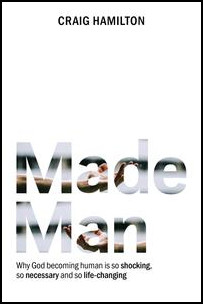Craig Hamilton’s Made Man: Why God Becoming Human is so shocking, so necessary and so life changing is a valuable and easy-to-read introduction to the incarnation. This is a book full of pithy descriptions and compelling ways of expressing biblical truths. I particularly appreciated that way that Hamilton’s phrase “God made meat” captures how strange and philosophically offensive the idea of an incarnate God is. (Shouldn’t that have been the book’s title?)
So why was “God made meat” in Jesus? Why does this strange Christian idea matter?

Christian theologians have given these questions a lot of thought over the centuries. Hamilton sets himself a high bar in attempting to communicate the essence of historic theological reflection on Jesus in an accessible way. Overall he does an excellent job. The book explores key Bible passages on the topic (chs.2-6), narrates the development of the orthodox doctrine of the person of Christ through the drama of early church councils (chs. 7-12) and finally explains the theological significance of Christ’s incarnation (chs.13-15). An appendix helpfully outlines the technical Christological terminology as it developed through successive church councils, including the confusing terminological confusion between the Greek East and Latin West.
There is a lot to love in this book. First, it sets out to make theology accessible to ordinary believers (which is exactly what the Stretch ministry is about). Hamilton manages to distill a great deal of biblical and theological reflection into a book that is straightforward, but not simplistic. It is written in an engaging and often entertaining style, but not in a way that cheapens the importance of what he discusses. It shows why the incarnation of Jesus is of essential saving significance, presenting the cross and resurrection as the ‘culmination’ of a saving mission begun by Christ in his incarnation. Readers will be enriched by Hamilton’s account of how the entire course of Christ’s obedience, from incarnation to cross, was of saving significance.
Hamilton has done some hard work digesting important ideas and working on how to communicate them clearly. Many who don’t have the benefit of formal theological study will benefit from this immensely. Also I dare say that not a few first-year church history and doctrine students will use it for exam revision.
This is not a perfect book. Those of us who dare try to popularisise academic ideas are forced to make some difficult choices about what to communicate and how to summarise things in a way that is accessible but won’t lead academic theologians and historians to groan painfully when they read them. Mostly Hamilton succeeds on this front. However, I have two areas of criticism.
First, in my opinion the book would have been stronger if chapter 12 (‘Monothelitism or Dyothelitism?’) was left out. Here Hamilton does a good job of outlining the seventh century theological issue of whether Christ had one will (Monothelitism) or two wills (Dyothelitism). The view that proved most convincing was that Christ had two wills, one human and one divine. However, I think this chapter ends up being counterproductive for reasons which I will discuss in an upcoming post.
My second area of criticism relates to the way in which the book connects the incarnation to the atonement. This book is full of the kinds of theological emphases that early church (‘patristic’) theologians made. It is therefore unsurprising to find several strands of patristic atonement theology (‘the work of Christ’) mixed in alongside patristic reflection on the person of Christ. As Hamilton rightly highlights, the person and work of Christ must not be separated. However, one major patristic idea was that the union of two natures (divine and human) in Christ’s incarnation was, in itself, saving. This idea can be called ‘deification’ or ‘divinisation’. The idea is that humanity lives in death and corruptibility whereas God is immortal, incorruptible, and is the very source of life itself. In this framework, when the divine Son took on human nature he thereby deified human nature, filling humanity with the divine life.
In the patristic worldview ‘human nature’ was a universal concept that all humans participate in. Thus, this line of thinking often leads to universalism. If human nature itself is deified in Jesus’ incarnation then this implies that all humans participate in the divine life. Hamilton doesn’t follow this universalist line of thinking (he is a Bible-believing, evangelical Christian), however he does describe the incarnation as though it is where humanity received divine life [p.210-213]. The problem is that this ascribes to the incarnation what the Bible attributes to Jesus’ resurrection instead. For example, Hamilton uses 1 Corinthians 15:54, a text about the death-swallowing power of resurrection life, to describe the effects of the union of divine and human natures in the incarnation [p.212].
The book’s theology gets most distorted, in my view, when it describes Jesus as ‘reconciling’ and ‘uniting’ God and man in his incarnation. That confuses the union of two natures in Christ with reconciliation between God and sinners (salvation). The end result is that the death and resurrection of Jesus are described as a conduit into the ‘reconciled space’ created by Jesus’ incarnational union of the human and divine natures [p.228-231]. Thus, the incarnation is presented as the momentous saving event that reconciles God and man, and the cross and resurrection are reduced to being the means of tapping into the saving-potential that exists in Jesus’ incarnate person.
This gets things backward. The New Testament never speaks of Christians as being united to Jesus’ incarnate humanity, but to his resurrected humanity. Of course, it is the incarnate Jesus who gets resurrected, but it is a question of which event is the source of Jesus’ bodily immortality that he then shares with his people. The Bible never says that Jesus possessed bodily-eternal life at his incarnation. He became truly human and was subject to the power of death just like the rest of us (cf. Hebrews 2:14-15). The amazing thing is that Jesus overcame our death-bound existence, winning over sin and temptation with the victory of his faithful obedience. He won resurrected life by his obedience to the Father, even to death on a cross (Philippians 2:5-11). Jesus was raised because it would have been wrong for him to remain dead; God would not let his holy one see decay (cf. Acts 2:27). Throughout the New Testament, Christians are said to share in the life of Jesus that he won in his resurrection (e.g. Romans 8:11; 1 Corinthians 15:42-46). We are never said to share in life brought about by the incarnation. Christians share in Jesus resurrected state, not his incarnate state.
Another way of saying the same thing is that Christians share in the life of Christ’s Holy Spirit. In the New Testament it is the Holy Spirit who is the source of Jesus’ bodily immortality, not Jesus’ divine nature. (More on that in my next post).
In sum, Hamilton echoes the patristic overemphasis on the inherent power of the divine nature in Christ by means of the incarnation. This in turn leads to an underemphasis on the Holy Spirit and the resurrection of Jesus as the source of divine life. The incarnation is the miracle that had to happen for the Son to undertake his mission to die on a cross. However, eternal life came to the man Jesus at his resurrection, not beforehand. This is why the resurrection is so central to hope laid out in the gospel. Until Jesus had died and was risen, he did not have eternal human life to share.
These criticisms ought not dissuade potential readers. In particular, if you want to understand the Christology of the creeds of the church this book is an excellent place to start.
